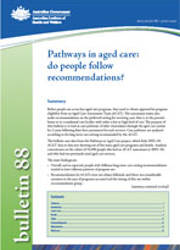Summary
Before people can access key aged care programs, they need to obtain approval for program eligibility from an Aged Care Assessment Team (ACAT). The assessment teams also make recommendations on the preferred setting for receiving care; that is, in the person’s home or in a residential care facility with either a low or high level of care. The purpose of this bulletin is to look at care pathways of older Australians through the aged care system for
2 years following their first assessment for such services. Care pathways are analysed according to the long-term care setting recommended by the ACAT.
The bulletin uses data from the Pathways in Aged Care project, which links 2003–04 ACAT data to data sets showing use of five main aged care programs and deaths. Analysis concentrates on the cohort of 34,400 people who had an ACAT assessment in 2003–04, and who had not previously used aged care services.
The main findings are:
- Overall, and as expected, people with different long-term care setting recommendations tended to have different patterns of program use.
- Recommendations by ACATs were not always followed, and there was considerable variation in the type of programs accessed and the timing of this use within recommendation group.
- One-quarter of ACAT clients—including some recommended to live in residential care—did not use aged care services in the 2 years after assessment, with only a small proportion dying shortly after assessment.
- Rates of transition into permanent residential care varied with the use of community care and residential respite care.
- Among those recommended to live in residential care, people who used neither community nor respite care services after assessment, or only residential respite care, were initially more likely to enter permanent residential care than others. People who used community care but not residential respite care were least likely to enter permanent care within 2 years of assessment.
Results suggest that use of community care delays entry into permanent residential care. For example, for people recommended to live in low-level residential aged care:
- 43% of those who had used both residential respite and community care had accessed permanent residential aged care within 12 months
- A similar proportion (46%) of those who had used neither residential respite nor community care had accessed permanent residential aged care within only 3 months.
Results also suggest that timing of the use of community care is important in delaying entry.
Further analysis is currently being done to assess the relationships between use of care services over time and client demographic and health characteristics.



